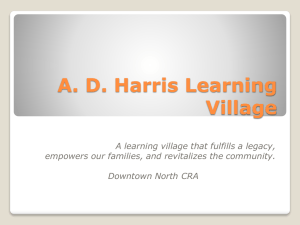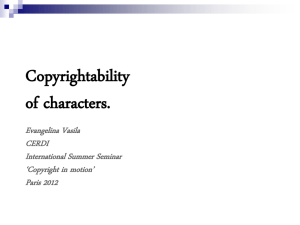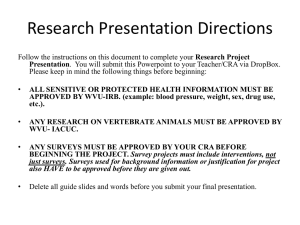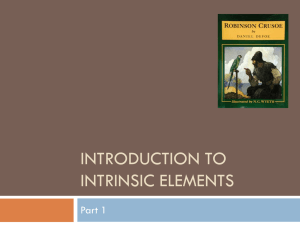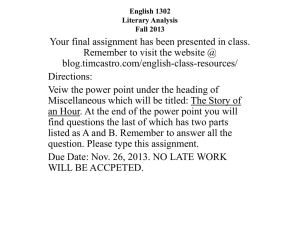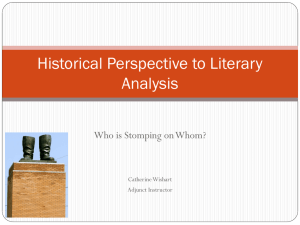Week 2 Subject Matter and Applicability of Copyright
advertisement
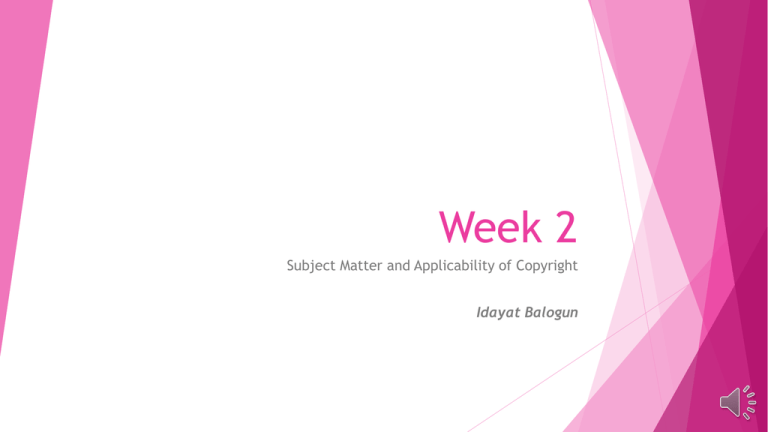
Week 2 Subject Matter and Applicability of Copyright Idayat Balogun Applicable laws The principal legislations are: 1. the Nigerian Copyright Act, Cap C.28 LFN, 2004 2. United States Copyright Act, Title 17 1976. Others are: 1. The Berne Convention for the protection of Literary and Artistic Works 1886 2. The Agreement on Trade – related aspects of Intellectual Property Rights, 1994 3. The World Intellectual Property (‘WIPO’) Copyright Treaty, 2002 4. Rome Convention for the protection of Performers, Producers of Phonograms and Broadcasting Organizations 1961 Nature of Copyright Copyright is the right to produce and distribute copies of an intellectual production. The whole gamut of this branch of law is to recognize that these rights resides in the writer or author of works only – Monopolistic There are two different kinds of right1. Moral Rights 2. Economic rights Moral rights gives the author ownership over its creation and protects the personal and reputational value of the work. Economic right on the other hand gives the author the monopoly to exclusively exploit his creation for a certain period. See 1st Schedule CRA for expiration of copyright. As such any third party who wishes to adapt the work of the author must do so with the author’s consent and approval. Nature of Copyright (Contd) Sections 5, 6, 7, and 8 of CRA gives the author of a work the exclusive right to control (subject to the exceptions specified in the Second Schedule to this Act) the reproduction, broadcasting, publication, performance adaptation or communication in any material form, the whole or substantial part of the work either in its original form or any other form derived from the original. Okilo v. Dickfrancis one of the exceptions in the 2nd Schedule of the Act is fair dealing Idea/expression distinction Copyright does not extend to idea but expression. Section 19.2 of the Trips Agreement However, the merger doctrine stipulates that where there is only one way of expressing an idea, that form of expression is not protected. See Alexander Haley’s case, 1978. The expression itself must have been fixed in a tangible or permanent form. Donoghue v. Allied Newspaper (1938) Ch. 106 at 109. The case of Green v. Broadcasting Corp of New Zealand (1989) 2 All ER 1056 further explained this principle. In that case the claimant tried to stop the defendant from copying the format for a television programme, ‘opportunist Knocks’. The Privy Council accepted the defendant’s argument that all they had taken was the idea. There was no work, such as a dramatic work to be copied, and they had not copied any particular broadcast, as they had created their own television programmes. Subject Matter of Copyright – US Law Section 102 of the USC provides for the subject matter of copyright. Section 102(a) – copyright protection includes: literary works (including any accompanying words; dramatic works (including any accompanying music); pantomines and choreographic works; pictorial, graphic; and sculptural works; motion pictures and other audio visual works ; sound recordings and architectural works. NB: original works of authorship of any sort can be protected. In other words, the above listed works is not exhaustive. Section 102 (a) USC Act Softwares are recently added to the list of protected works under the USC Subject Matter of Copyright – Nigerian Law Sections 1, 51 and part II of the 2004 CRA Act contains provisions as it relates to the subject matter of Copyright protection. Whilst section 1 gave a broad categories of works protected, section 39 defines more succinctly the types of works contemplated within these broad categories. Part II on the other hand contains some provisions concerning protection of some other categories of works generally classified as neighboring rights. Section 1 Works eligible for copyright protection under this section are: literary works; musical works; artistic works; cinematograph films; sound recordings and broadcasts. Subject Matter of Copyright – Nigerian Law Part II – Neighboring Rights Neighboring rights include the right of performers and protection of expression of folklore. Section 26 CRA provides that a performer shall have the exclusive right to control, in relation to performance, the following acts: performing, recording, broadcasting live, reproducing in any material form; and adaptation of the performance. Section 26(2) defines performance to include a dramatic performance (which include dance and mine); a musical performance; and a reading or recitation of literary act or any similar presentation. Section 31 CRA also protect the expression of folklore against reproduction, communication to the public by performance, broadcasting, distribution by cable or other means; adaptation, translations and other transformations when such expressions are made either for commercial purposes or outside their traditional or customary context. Section 32 CRA charges the Nigerian Copyright Commission the right to protect against the infringement of folklore. Eligibility for protection – Originality See Sections 1 (2), (3) and (4) of CRA, 2004 OriginalityA literary, musical or artistic work shall not be eligible for copyright unless sufficient effort has been made to give the work an original character and the work has been fixed in any definitive medium of expression. Originality is a fundamental principle of a copyright, it is in fact regarded as the basis of the protection given by the law of copyright to particular forms of expression. Originality does not mean that the work must be necessarily novel or new. That is the author does not have to be the first person to say something in order to be able to have to be the first copyright protection of it. See University of London Press Ltd v. University Tutorial Press Ltd (1916) 2 Ch. 601 at 608 Eligibility for protection – Originality (Contd) Originality is more concerned with the manner in which the work was created and that the work truly emanated from the author. Per Justice Pearce in Ladbroke (Football) Ltd v. William Hill (Football) Ltd (1964) 1 WLR 273 at 291 Thus originality for the purpose of copyright law is not originality of ideas or thought but originality in the execution of the particular form required to express such ideas or thought. Eligibility for protection – Fixation The requirement of fixation (permanent form) - protection arises once a work is completed. The Rome Convention on the Protection of Performers, Producers of Phonograms and Broadcasting Organizations, 1961 requires the affixation (date of publication and author’s name) of a copyright notice to the work. The Act requires that the work must be fixed in any definite medium of expression now known or later to be developed, from which it can be perceived, reproduced or otherwise communicated either directly or with the aid of any machine or device. Section 1 (2) (b) Copyright Act, 1990. Thus, for works to be eligible for protection under the CRA as well as the USC, the work must be original and be fixed in a permanent medium. Literary, artistic, musical and dramatic works - explained Literary Works - Section 51 CRA 2004 defines literary works to include (a) novels, stories and poetic works; (b) plays, stage directions, film scenarios and broadcasting scripts; (c) choreographic works; (d) computer programmes; (e)text-books, treatise, histories, biographies, essays and articles; (f) encyclopedias, dictionaries, directories and anthologies; (g) letters, reports, and memoranda; (h)lectures, addresses and sermons; (i)law reports, excluding decision of courts; (j)written tables or complaints. The Courts are however prepared to look widely to what may constitute a literary work. See University of London Press Ltd v. University Tutorial Press Ltd (1916) 2 Ch. 601 at 608. Literary Works (Contd) Section 6(1) (a) CRA 2004 – Owner of a literary work has the exclusive right to control the doing of any of the following acts: (i) reproduce the work in public; (ii) publish the work; (iii) perform the work in public; (iv) produce, reproduce, perform or publish any translation of the work; (v) make any cinematograph film or a record in respect of the work; (vi) distribute to the public, for commercial purposes, copies of the work, by way of rental, lease, hire, loan or similar arrangement; (vii) broadcast or communicate the work to the public by a loud speaker or any other similar device; (viii) make an adaptation of the work; (ix)do in relation to a translation or an adaptation of the work. Artistic works Section 51 CRA defines artistic works to include any of the following work (s) similar thereto: a) paintings, drawings, etchings, lithographs, woodcuts, engravings and prints; (b) maps, plans and diagrams; (c) works of sculpture; (d) photographs not comprised in a cinematographic film; (e) works of architecture in the form of buildings models; and (f) works of artistic craftsmanship and also (subject to section 1 (3) of this Act) pictorial woven tissues and articles of applied handicraft and industrial art; Musical works Copyright in music differs from copyrights in literary and dramatic works in the sense that there exist two kinds of copyrights in musical works. these are: 1. Copyrights in musical composition - section 102 (a) USC refers to this as copyrights in musical works including any accompany words; 2. Copyright in sound recordings (this was added in 1972 as a subject matter of copyright by US Statute). Sound recording is defined as the fixation of a sequence of sound capable of being perceived orally and of being reproduced but does not include a sound tract associated with a cinematograph film. Cinematograph Works Cinematograph film has been defined to include the first fixation of a sequence of visual images capable of being the subject of reproduction, and includes the recording of a sound track associated with the cinematograph film. Section 51 CRA The owner of cinematograph work has the exclusive right, to do or authorize the doing of any of the following acts, that is- (i) make a copy of the film, (ii) cause the film, in so far as it consists of visual images to be seen in public and, in so far as it consists of sounds, to be heard in public, (iii) make any record embodying the recording in any part of the sound track associated with the film by utilizing such sound track, (iv) distribute to the public, for commercial purposes copies of the work, by way of rental, lease, hire, loan or similar arrangement. Section 6(1)© CRA NB: Copyright also extend to broadcast Conclusion In conclusion, it is important to understand that for work to be protected under the Copyright Act, it must have been seen to be original and also be fixed in a permanent medium. For instance, if it is a music, it must have been recorded, if it is a book, it must have been written. Lastly, Copyright unlike trademarks and patents, need not be registered to be protected. The copyright registration at the Nigerian Copyright Commission (NCC) is purely for administrative purposes. Sometimes people confuse depositing with the National Library as registration of copyright . But it is not. In the case of I.C.I.C (Directory Publishers) v Ekko Delta (1977) F.H .C.L.R 346 it was held that when a Plaintiff on publication of a book deposited a copy with the National Library of Nigeria and was given a code number as evidence of registration , the said registration is not copyright registration or evidence thereof[ See IIIC STUDIES,Studies in Industrial Property and Copyright Law Volume 21 by Folarin Shyllon -Intellectual Property in Nigeria]
